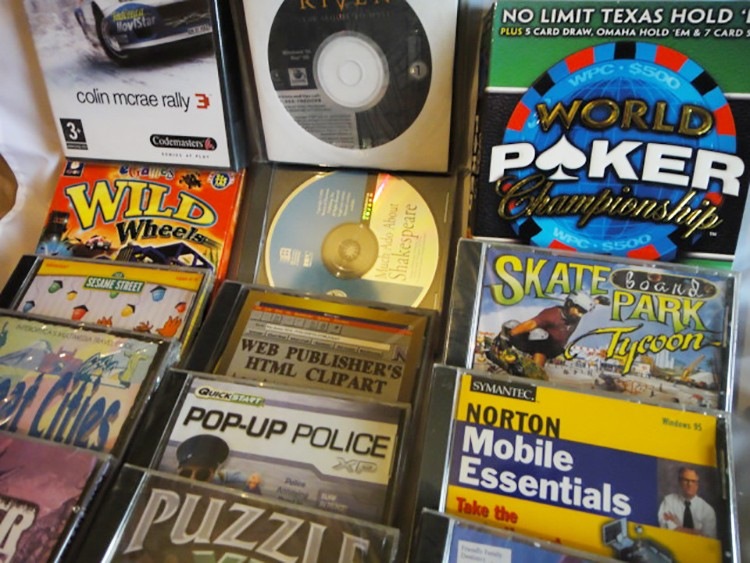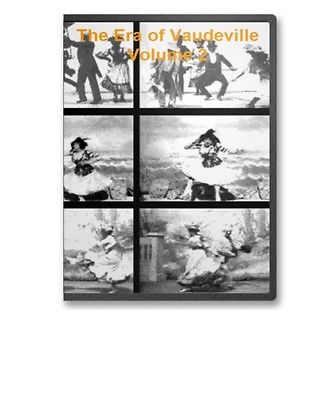The Historical Archive Sample Page
The Era of Vaudeville
Volume 2 (Containing 29 films) The Era of Vaudeville is comprised of a total of 60 motion pictures. This auction is for Volume 2, which contains 29 films. Films include animal acts, burlesque, dance, comic sketches, dramatic excerpts, dramatic sketches, physical culture acts, and tableaus. Many of the films were produced from 1897 to 1920. The remaining films were produced by Hans A. Spanuth in Chicago from 1919 to 1920 for the series "Spanuth's Original Vod-A-Vil Movies." These motion pictures present a rare animated record of vaudeville acts from the turn of the century. Although not actually filmed on a theatrical stage, they sought to recreate the atmosphere of a theater performance by showing the types of vaudeville acts and performers that were popular at the time.
Below are sample clips from four of the films on this CD
Here is a of each film on this CD
Betsy Ross dance
CREATED/PUBLISHED United States : American Mutoscope and Biograph Company, 1903.
SUMMARY Opens on a bare stage with a painted backdrop of an interior theater wall and pillar. From screen right, a woman twirls onstage and performs an enthusiastic dance. It appears she is a woman dressed to look like a little girl, in a short, ruffled dress and sash, tights, and ballet slippers, with long, dark hair worn in curls. Her movements include some with an apparent ballet influence, such as pirouettes and walking on pointe. She also performs various feet and leg movements, leg kicks both to the front and side, spins, and twirls, all the while flouncing and lifting her skirt and smiling coquettishly. She ends by throwing a kiss to the camera as she twirls offstage.
Cake walk
CREATED/PUBLISHED United States : American Mutoscope and Biograph Company, 1903.
SUMMARY Five African Americans--three men and two women--perform a cakewalk, a dance featuring fancy strutting that was named after the prize awarded in the original contests. The dancers wear rather formal attire, with the men in dark suits and black tie and the women in full-length, high-collared dark dresses; one woman carries a small American flag. As they step in place against a light background, the center male--holding up a top hat and twirling a cane--moves toward the camera and briefly performs some fancy steps. As he moves back, the man at the left end of the line does a quick twirling step and links arms with his partner. The other two dancers also pair off as the center male leads them in a strutting movement around the stage. When they return to the original line, all five step towards the camera with the center man slightly ahead of the others. The film ends just as they stop the cakewalk.
Charity ball
CREATED/PUBLISHED United States : Edison Manufacturing Co., 1897.
SUMMARY A man in formal dinner clothes and a woman in a white ruffled dress with a flower corsage and white shoes execute various dance steps designed as exhibition dancing. The set is bare, without backdrops or props. The couple's feet are not evident at times in the frame, and the dance appears to have been shot in relatively slow motion.
Comedy cake walk
CREATED/PUBLISHED United States : American Mutoscope and Biograph Company, 1903.
SUMMARY Five African Americans--three men and two women--perform an exaggerated cakewalk in fancy evening clothes. Two of the men wear formal black tie in tuxedos with tails, while the third wears a gray tux of shiny material with an extremely long overcoat and exaggerated cuffs. All have matching top hats and canes. The women wear highly decorated hats and tight-fitting, frilly dresses of only mid-calf length, with one hand on their hip pulling up that side of the skirt. Two couples step in time against a white background as the third, center man prances forward and executes a comedic, wobbly-kneed step. He then moves back to lead the others in the strutting around the stage, all the time spinning and prancing among them. As the couple to stage left jaunt past the camera, the woman pauses to hitch up her stocking. The man in the gray suit on the right twirls his cane and struts toward the camera with his partner; they then pause on opposite sides of the frame. The woman kisses a handkerchief she is holding in one hand and flirtatiously throws it on the ground. As the man smiles knowingly and reaches for it, however, the woman yanks the fabric back to her on a string. Both laugh and continue strutting. All five dancers then return to a line and start a fancy step towards the camera.
Crissie Sheridan
CREATED/PUBLISHED United States : Thomas A. Edison, Inc., 1897.
SUMMARY A woman in a white gown performs a skirt dance, using her arms to produce circles and other patterns within the folds of her costume. Her legs and feet appear to be bare.
Dance, Franchonetti Sisters
CREATED/PUBLISHED United States : American Mutoscope and Biograph Company, 1903.
SUMMARY Three young women with dark, curly hair stand on a stage with a black background and patterned carpet or tile underfoot. They wear tights, ballet shoes, and frilly dresses to the knee with multiple petticoats and ruffled drawers. They begin by raising their right legs up by their heads, and then perform a dance with a variety of kicks and leg movements, their hands either in the air or pulling up their skirts. The sisters also grab their right legs again and hop in a circle, then do cartwheels and land on the floor in the splits. Jumping back to their feet, the women twirl in circles and around each other in circles in what appears to be a type of pirouette, while holding up their skirts and showing their bloomers in a manner similar to the cancan.
Foug re
CREATED/PUBLISHED United States : American Mutoscope and Biograph Company, 1899?
SUMMARY Opens on a stage with a painted backdrop of what appears to be clouds K.R. Niver sees the background as rolling waves . From the left of the frame enters Eugenie Foug re in a strutting type of leg movement, shot in profile but with her face turned toward the camera. She wears a dress with a dark, lace-patterned, low-cut bodice, striped sleeves, and a frilly white skirt to the knees; multiple dark petticoats and white bloomers to the knees; stockings; heeled shoes; and an tri-corner hat with a feather. Other dance movements include a backwards shuffle step, clutching her bosom and then cupping her ear as if listening with a skipping foot movement, and a sideways step across the stage. For most of the dance she lifts her skirt high in a manner similar to a cancan. She closes by kneeling in a brief curtsy with her hand tucked at her chin, and then exits the stage.
Foxy Grandpa and Polly in a little hilarity
CREATED/PUBLISHED United States : American Mutoscope and Biograph Company, 1902.
SUMMARY Opens on a stage with a stone fence and a painted backdrop of a forest or garden. Husband and wife team of Hart and DeMar as cartoon characters Foxy Grandpa and Polly enter hand-in-hand from behind the fence. Grandpa has a bald pate with bushy white hair on the sides, a big bulbous nose, and a potbelly, dressed in a light-colored suit with a vest and spats and carrying a bowler in his left hand. Polly wears a ruffled, light-colored dress with dark trim that goes to her ankles, a bedecked bonnet, white stockings, heeled shoes, and a choker around her neck. Both are smiling broadly as they reach center stage and begin their vaudeville-style dance, with tap, soft shoe, and other synchronized leg movements and twirls in what appears to be a ragtime rhythm.
A nymph of the waves
CREATED/PUBLISHED United States : American Mutoscope and Biograph Company, 1900?
SUMMARY Superimposition of a woman dancing over footage of crashing waves from the rapids of Niagara Falls. The woman wears a frilly, perhaps feather-trimmed, white dress with a low-cut bodice, a matching feathered hat, white stockings, and white ballet slippers. She holds up her skirt through the entire dance, revealing her ankles and lower legs as well as a flash of a garter above the knee on her left leg. Her movements appear to be a mixture of ballet and variety-style dancing such as a cancan, including spins and toesteps on pointe. She closes with a flourish of her skirt as she executes a curtsy on pointe with one foot.
A tough dance
CREATED/PUBLISHED United States : American Mutoscope and Biograph Company, 1902.
SUMMARY From either side of a white, apparently outdoors, setting enter a man and woman, both wearing ragged street clothes and caps. As they approach center stage, the man grabs the woman's arm and pulls her to him, then slaps her. Still holding her arm, the man and his partner cockily strut towards the camera. The man grabs the woman in a crouched, bear-hug type of hold and they perform a rough little dance that almost seems a parody of a waltz. In a jerky type of jitterbug, the man twirls the woman out of his hold and back again, a movement which is repeated often within their spinning dance. They finally fall to the ground, still clutching each other, and roll around.
Duel scene, "By right of sword"
CREATED/PUBLISHED United States : American Mutoscope and Biograph Company, 1904.
SUMMARY Opens on a stage with a painted backdrop of a lake surrounded by forest. A bearded man wrapped in a dark cloak and wearing a dark fur shako--apparently the novel's character of Major Devinsky--stands stage left. Behind him, a group of three soldiers move about impatiently, watching for someone offstage. According to Marchmont's story, the men should be late 19th century Russian soldiers, but in the film they wear military uniforms that seem French in design instead, with light-colored breeches sporting embroidered designs, dark buttoned jackets with another coat slung over one shoulder, dark fur shakos with plumes, and shiny black boots to the knee. From stage right enters the story's main character of Hamylton Tregethner, masquerading as infantryman Alexis Petrovitch in a similar uniform and cloak. The duelers remove their cloaks and jackets, roll up their shirtsleeves, and accept their swords from the soldier acting as "second." The portion of the book where Tregethner tries to persuade Devinsky to abandon the duel is presented on film as a pantomimed discussion, then the two opponents face each other and the duel is started. During the swordfight, Tregethner is brought to his knees at one point, but prevails and ends the duel by cutting Devinsky on the arm. As the loser storms off the stage, one of the soldiers salutes the victor.
A ballroom tragedy
CREATED/PUBLISHED United States : American Mutoscope and Biograph Company, 1905.
SUMMARY Opens on a set of a sitting room, apparently off a ballroom where dancers occasionally can be glimpsed through a curtained entrance stage right. Near the entrance, a young couple in formal attire talk--perhaps angrily--as another couple exit the dancing. The second man introduces his companion--a striking woman in a risqu white gown with a low-cut bodice and bare shoulders--to the other man and then reenters the dance hall. The young man apparently excues his female companion, who is plainer in comparison with the new arrival, and invites the woman in white to join him on a settee. The two talk closely and affectionately, as the spurned woman returns with a knife in her hand and hides in the curtain behind the sitting couple. When the two kiss, she reaches out and stabs her rival in the back. The injured woman jumps up in pain and then collapses on the floor, apparently dead. The murderess runs away as the young man rushes to hold the fallen woman.
Fights of nations
CREATED/PUBLISHED United States : American Mutoscope and Biograph Company, 1907.
SUMMARY Part 1: In "Mexico and Spain," a man dressed as a Mexican peasant spies on a happy young woman and her suitor, who wears a fancy Spanish, matador-style outfit. The woman dances for her companion, then the couple embrace and sit on a stone bench, holding hands. The jealous peasant rises from his hiding place to stab his rival, but the woman grabs his arm and stops him. The two men engage in a fierce knife fight, with the woman at one point helping her suitor regain his lost weapon. The Spaniard finally disarms his opponent, but consents to the woman's begging and spares the peasant's life. -- "Our Hebrew Friends" opens to a street set with a painted backdrop of storefronts. A man apparently identified as Jewish through his dark hair and full beard argues with a Jewish necktie peddler. The argument soon escalates into a shoving match, through which a portly gentleman tries to pass. A third man, also apparently Jewish, happens upon the scene and soon joins the fight. The three men turn in a circle kicking each other until a policeman arrives and breaks them apart. The third man draws the officer aside with an offer of a bribe, which the policeman happily accepts. The money, however, is apparently taken back secretly when the two shake hands, and the three men rejoice after the policeman walks off.
Part 2: "'Hoot mon!' A Scottish Combat" opens with the end of a duel between two uniformed men in kilts as one falls to the ground wounded. A third kilted man enters and sees the fallen man, and in turn fights with the victor with swords and shields. The third man ultimately disarms his opponent and stands victorious with his foot upon the man's chest. -- "Sunny Africa, Eighth Avenue, New York" takes place in an African-American dance hall. After a dance number, a young man in a cap and striped shirt sits for a drink with his female companion. He is soon induced, however, to perform an energetic tap dance as the other patrons watch and clap. When he is motioned outside after the dance, an older suited gentleman notices his absence and introduces himself to the young woman, who invites him to sit down. They have a drink and are dancing a lively cakewalk when the young man returns and angrily breaks them apart. The two men draw la
 Login
Login
 Login
Login












